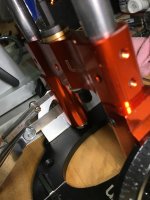DeformedTree
Member
- Joined
- May 19, 2018
- Messages
- 1,341
Svar said:I agree. I deal with precise instruments and "adjusting screws" are not just a good thing, they are critical. Machines get damaged, parts wear out, parts get replaced. You need a way to tune thing up.Michael Kellough said:[member=68063]DeformedTree[/member] I’ve bought a bunch of expensive tools and I can’t think of a single one that arrived perfect in respect to alignment. Most are close enough that I can live with the slight discrepancy. I the case of a router the slight misconcentricity can be used to adjust a dado on the fly by referencing difference parts of the base.
When something really must be tweaked to be useful the presence of adjusting screws is way more useful than the lack. Hit or miss is not adjusting. It’s just gambling.
To be clear, I'm not talking lab instruments, items that need to be sent out for yearly calibration, that is a completely different world and situation.
Far as parts getting damaged, yes, that can happen, and modern manufacturing and quality control means you can swap out a replacement part and it's still hits the original specs. Far as parts wearing out, parts that wear out mean either further bad design, or the whole item has got to end of life were all of it has worn out at the same time. A company is suppose to select a life of something and design the parts to hit that, all of them. Less than target is a fail, and designing some of the parts to last way longer than the rest of it is a waste. If the design accepts some of the parts are service parts to hit a total life expectancy, replacement of those parts will not cause a need for adjustments.
If tools come not adjusted right, that is a fail on the manufacture. There being an adjustment shouldn't be met with "oh good" it should be met with scorn. If people accept this as good, then the manufactures have no reason to do better and they lower the bar on themselves.
This problem unfolded with cameras a few years ago. Manufactures found they could have software adjust for bad lens assembles by having the camera calibrate itself to each lens. It was sold as a great thing, in fact it's not and just gave camera makers a path to not hold lenses to the higher tolerances they used to. The other end is manufacturing such as automotive. You will struggle to find items that have adjustment in a car anymore as they learned it's much cheaper and better quality to design the parts right, hold tolerances on the manufacturing side, and then anyone can bolt it together and it works every time. More upfront cost, but end cost are far less and the end product is much better.
An adjustment is just something that is going to get out of adjustment. In a lot of cases you will not have the tools or fixtures to get something back into adjustment. Look at a saw like a TS55, it didn't need to be so bad and trying to square it up is almost impossible because so many different moving parts. Now you have a saw that a user won't ever want to tilt for fear of getting it back square again.
There are places where there has to be adjustments as there is no practical way to get the tolerances tight enough, but the bulk of things when it comes to tools are not this. In this case, it it came down to just adjusting the speed the machine the housing, or improving the tooling fixture for it, or a different cutter, or finishing it up with a grinding stone or a reamer (one more step on the same machine) they could have just fixed it. If the router was some cheap thing from harbor freight, I can see it having adjustments to make up for very poor design/cost cutting. But if I'm spending festool money I expect them to have it come out of the box dead on and stay there.


